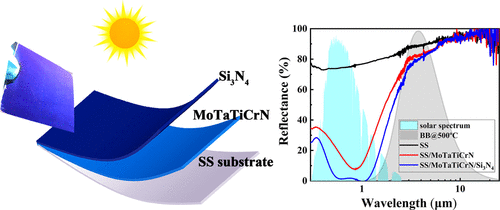Abstract
Recent advances in high-entropy alloys have spurred many breakthroughs in the fields of high-temperature materials and optical materials and they provide incredible application potentialities for photothermal conversion systems. Solar-selective absorbers (SSAs), as key components, play a vital role in photothermal conversion efficiency and service life. The most pressing problem with SSAs is their inconsistent optical performance, an instability constraint induced by thermal stress. A feasible method of improving performance stability is the introduction of high-entropy materials, such as high-entropy alloy nitrides. In this study, enabled by an intrinsic MoTaTiCrN absorption layer, the solar configuration achieves greatly enhanced, exceptional thermotolerance and optical properties, leading to the formation of a scalable, highly efficient, and cost-effective structure. Computational and experimental approaches are employed to achieve optimum preparation parameters for thicknesses and constituents. The crystal structure of high-entropy ceramic MoTaTiCrN is fully investigated, including thickness-dependent crystal nucleation. High-temperature and long-term thermal stability tests demonstrate that our proposed SSA is mechanically robust and chemically stable. Moreover, a low thermal emittance (15.86%) at 500 degrees C promotes the photothermal conversion efficiency. In addition, due to the exceptional spectral selectivity (alpha/epsilon = 92.3/6.5%), thermal robustness (550 degrees C for 168 h), and photothermal conversion efficiency (86.9% at 550 degrees C under 100 sun), it is possible for our proposed SSA to enhance the practical realization of large-area photothermal conversion applications, especially for concentrated solar power systems.

Keywords Plus:MECHANICAL-PROPERTIESOPTICAL-PROPERTIESCOATINGSSTABILITYFILMSTIN
Published in ACS APPLIED MATERIALS & INTERFACES,Volume 13;10.1021/acsami.0c23011,APR 14 2021


